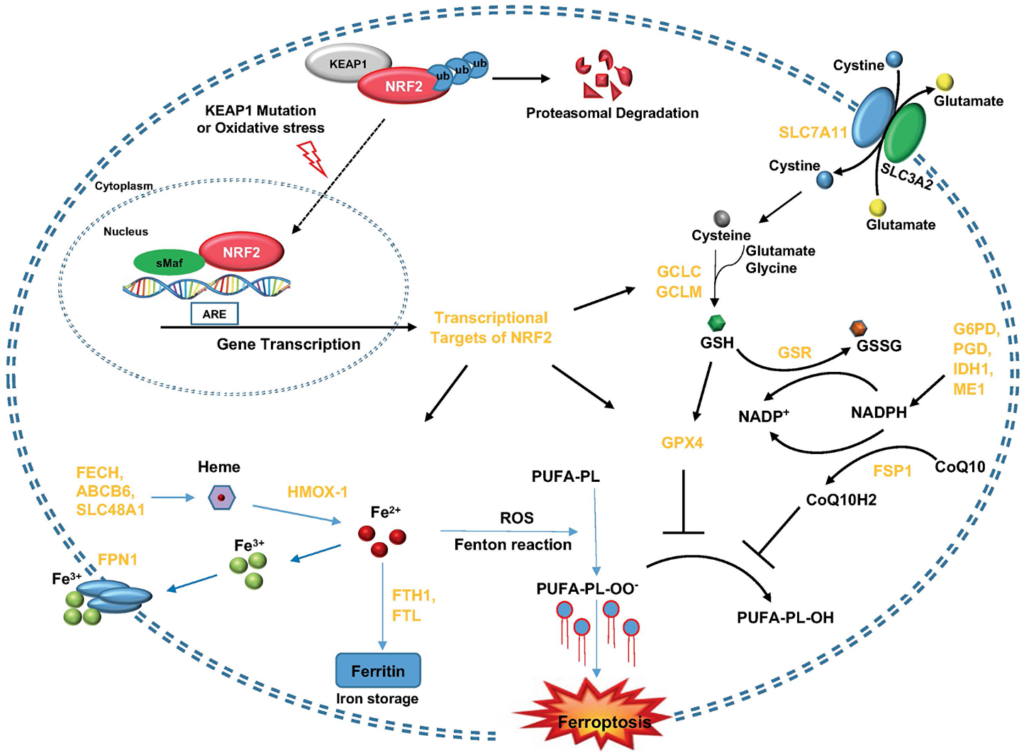Researchers published a research perspective about a recent study that uncovered FSP1 as a novel target gene that mediates ferroptosis resistance and radioresistance in lung cancer cells.

Ferroptosis is a type of cell death caused by the accumulation of iron and lipid peroxides in cells. Cancer cells are often resistant to ferroptosis, which allows them to survive and proliferate. Radioresistance is another common feature of cancer cells that allows them to resist the effects of radiation therapy.
A new research paper (published on April 22, 2022) identified ferroptosis suppressor protein 1 (FSP1) as a novel KEAP1/NRF2 target gene and demonstrated that FSP1 plays an essential role in NRF2-mediated ferroptosis resistance and radioresistance in KEAP1-deficient lung cancer cells.
Recently, researchers Nsengiyumva Emmanuel, Hongen Li, Jing Chen, and Yilei Zhang from Xi’an Jiaotong University, Ruyang People’s Hospital and Shaanxi Jiuzhou Biomedical Science and Technology Group wrote a paper about the implications of these findings. On October 19, 2022, their research perspective was published in Oncotarget’s Volume 13, entitled, “FSP1, a novel KEAP1/NRF2 target gene regulating ferroptosis and radioresistance in lung cancers.”
“In a recent study by Pranavi Koppula et al. from The University of Texas MD Anderson Cancer Center, FSP1 was demonstrated as a novel target of NRF2 and to play a vital role in KEAP1/NRF2-mediated ferroptosis regulation [13], which reveals the important role of genetic regulation of FSP1 in cancer development.”
The KEAP1-NRF2 regulatory pathway is crucial for protecting cells against oxidative damage. In lung cancer cells, KEAP1 mutations lead to NRF2 deregulation and contribute to tumorigenesis. Researchers have been searching for an effective way of targeting this pathway in cancer cells to sensitize them to ferroptosis/radiation-inducing agents. They found that FSP1 is upregulated in KEAP1-mutant lung cancer cells, and its expression is associated with resistance to ferroptosis and radiotherapy. Coenzyme Q10- (CoQ) FSP1 signaling represents a potential target for overcoming resistance to ferroptosis and radiotherapy in KEAP1-mutant lung cancer cells.
“Currently, there are four major ferroptosis-defending systems, while NRF2 could directly control two of them, SLC7A11/GSH/GPX4 axis and CoQ/FSP1 axis.”
This study provides new insights into the role of target genes in the KEAP1-NRF2 pathway and how they contribute to cancer cells’ resistance to ferroptosis and radiotherapy. However, the mechanism by which KEAP1-NRF2 target genes mediate resistance to ferroptosis is not yet fully understood. Fortunately, the identification of FSP1 as a key target gene involved in this process opens up new therapeutic avenues for the treatment of lung cancer.
“Here, Pranavi Koppula and her colleagues’ study indicates that pharmacological targeting of CoQ-FSP1 signaling to overcome KEAP1 deficiency-induced radioresistance could be a potentially effective therapeutic strategy in treating KEAP1 mutant lung cancers.”
Click here to read the full research perspective published by Oncotarget.
ONCOTARGET VIDEOS: YouTube | LabTube | Oncotarget.com
—
Oncotarget is an open-access journal that publishes primarily oncology-focused research papers in a continuous publishing format. These papers are available at no cost to readers on Oncotarget.com. Open-access journals have the power to benefit humanity from the inside out by rapidly disseminating information that may be freely shared with researchers, colleagues, family, and friends around the world.
For media inquiries, please contact media@impactjournals.com.



